What Is A Product Roadmap? A Comprehensive Guide With Examples
This blog aims to clarify the significance of roadmaps in Product development. It provides a comprehensive insight into different roadmap types, their objectives, key components to incorporate, and the step-by-step process of creating roadmaps. You will coordinate your resources and product vision better to drive successful results.
It’s important to bring innovative features and products to market, focusing on the product and flawless execution. It can be challenging to decide what features to build next for a product when customers’ desires constantly change. Therefore, having a unique and different product strategy that convinces the internal stakeholders is vital for your success. A product roadmap is crucial in coordinating your resources and vision for the product to ensure that your development and product teams stay focused throughout the product life cycle and deliver results.
This article will give you a complete guide about what is a product roadmap, how to build a product roadmap, and how to manage and present it effectively. It will also cover some product roadmap examples and templates at the end.
What is a Product Roadmap?
A product roadmap is a long-term visual depiction of your goals, priorities, and product development. It helps organize, encourages agreement, and informs all organization members about important short and long-term goals and decisions.
Product managers can effectively outline a project’s development using roadmaps. It assists with project control, time, money, and resource allocation.
Even if you have a fantastic product design, it needs a proper roadmap and plan. Following a thorough roadmap, transform your product vision and strategy into concrete projects and activities your team can work on daily. It is also called your strategic vision, which clearly outlines the products you are creating and the reasons behind their development.
Product roadmaps are relatively high-level compared to strategy plans, which concentrate on the specific activities needed during product development. A helpful roadmap covers every possible query that could come up while developing a new product. To guarantee the product’s success, it must be adaptable enough to any changes that may arise during the process.
Why is a Product Roadmap important?
Let us discuss its importance. Roadmaps are practical tools for communication. But there are a few more significant reasons why adopting one is essential:
- It supports your plan and vision: First and foremost, roadmaps are communication tools. They are the only reliable source of information for anyone who needs clarification about your product vision and priorities.
- It plans actions to implement your strategy: Roadmaps are thorough yet maintain enough abstraction for general understanding. They assist in concentrating on crucial tasks without getting entangled in minor details.
- Builds trust: A roadmap helps foster trust and confidence in your organization from top to bottom.
- Enhances planning & discussions: A roadmap is more of a conversation than a set of rules. It enables everyone to share input, raise concerns, and ask questions upfront, saving time and resources.
- It unites your team: Teams united by a common goal and aligning with their business’s vision operate more profitably and productively. A roadmap is one of the most crucial tools for inspiring everyone for the future and having all of them on the same page.
Who uses a Product Roadmap?
Before jumping into how to build a product roadmap, it is vital to understand who uses it. This will help you and your team to comprehend it better:
Business owners and managers create roadmaps to explain product strategies, tools, and efforts to external stakeholders and product developers. They are essentially the only document that will keep a product’s development on course and, for the most part, guarantee that all parties involved are in agreement. You can use it with other business plans, such as business and marketing strategies. They can guide you in expanding your marketing plan.
What makes a good Product Roadmap?
A well-designed roadmap provides a high-level, visual summary of your project’s objectives, timeframe, long-term course, and future iteration plans. Using roadmaps, teams overseeing product management assign team members to each project stage. In addition to successfully prioritizing project activities, you can achieve it by doing the following things:
- Monitor the overall development toward the final product objective.
- It must facilitate open communication and transparency amongst internal and external stakeholders.
- It must foster substantial team agreement and knowledge on the path of the product.
- Organize assignments and endeavors among groups.
What to include in a Product Roadmap?
Roadmaps can be complicated to make; therefore, before knowing how to build a product roadmap, you must understand what to include in it. They vary based on the kind of product, the industry it belongs to, the size and composition of the product team, and the specific requirements of the business. Although roadmaps may vary, they typically share some common elements:
Product features: It refers to the tasks a product must complete and the issues it must resolve. Usually, the development team selects which features to add after reviewing customer feedback.
Storylines: User stories are the fundamental building blocks of a roadmap. Their purpose is to describe the ultimate purpose of a product feature from the point of view of the end users.
Product releases: As stated in the roadmap, users have access to new features during scheduled product releases. Postponing the implementation of one item until the completion of other items can enable the incorporation of multiple features in a single release.
Product initiatives: These exemplify how groups of tasks, projects, features, and stories work together to achieve specific product objectives. Initiatives help focus on the goal-centric efforts of the teams.
Product goals: They describe the objectives a company or development team aims to accomplish with a specific product. It is helpful to have these goals in mind to develop products.
Product timelines: A product roadmap timeline lists the teams and individuals responsible for each process. It also mentions the stakeholders influenced by various updates during the product development. It will also typically include the dates connected with each milestone.
Cost: It is essential to include the estimated development costs while making your roadmap. You can adjust if expenses are high or resources are scarce for successful execution.
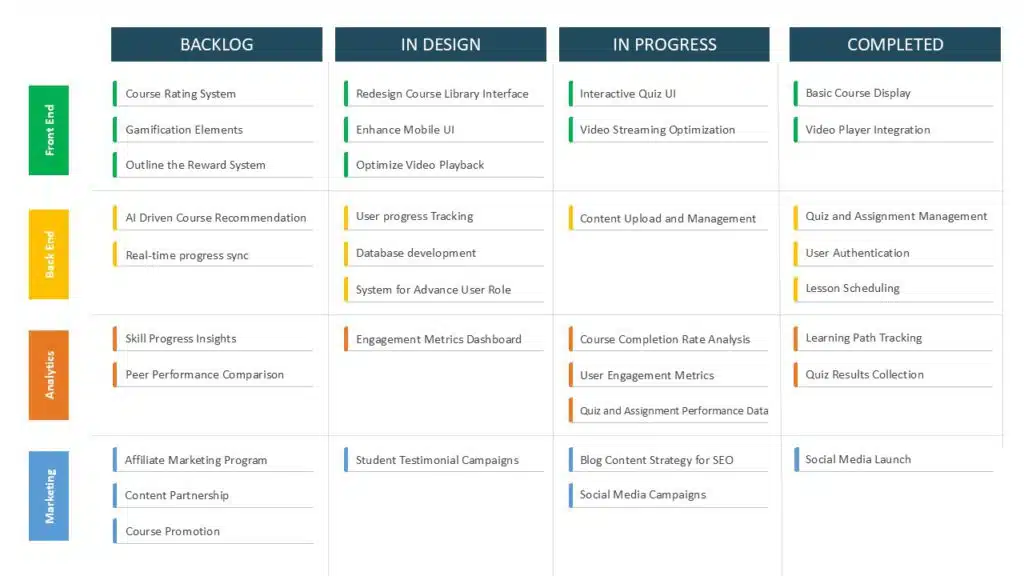
How to build a Product Roadmap?
You can achieve a roadmap that is effective and in line with your company’s overall business plan by following a few crucial stages. It would help to clearly understand your desired end product before creating your final roadmap. It includes determining the essential demands of your target market, pinpointing the value proposition of your product, and identifying what your client wants.
Additionally, a product strategy connected to your organization’s overarching business strategy and strategic goals is necessary to develop a roadmap successfully. Now let us see how to build a product roadmap and the steps involved in it:
1. Incorporate User Stories
Comprehending your target consumer base is crucial for creating a compelling product plan. It entails gathering input to determine their requirements, preferences, and pain points. Remember this knowledge as you build new products. Subsequently, create user stories to understand how users perceive the value of your product. Through a comprehensive understanding of target consumers’ wants and preferences, user stories can assist in the formulation of roadmaps.
2. Prioritize Features According to Client Needs
Once you have a solid understanding of the needs of your target market, prioritizing your product features by those needs can be time-consuming. To avoid this, you must prioritize your development efforts by determining the most crucial features to benefit your target clients.
For example, when developing a B2B sales tool and focusing on small firms as your market, consider prioritizing lead management capabilities in your product. These features would streamline the process for small sales teams to collect contact details and track previous interactions with potential customers.
3. Choose Key Performance Indicators
Determining the critical indicators to gauge impact is essential to ensuring your product roadmap is doing well. Imagine that you are creating a plan for an app that facilitates teamwork. Key performance indicators that could be most important for the product are:
Tracking active users, daily logins, and the amount of time spent on the app by each user. All these help to gauge user engagement. Use the amount of paid memberships or in-app purchases to track revenue growth. Use Surveys or app review analysis to measure customer attitude and feedback. By selecting and monitoring critical metrics, the product team may better understand how their roadmap affects the app’s success and make informed decisions to enhance it.
4. Establish Realistic Tasks and Deadlines
It’s time to create a workable schedule for your product development process based on your established product strategy and feature prioritization. To build a timetable, list all the tasks to complete, rank them in order of importance, and calculate the approximate time needed to finish each activity. Using this data, list the precise dates for every task.
It offers checkpoints for assessing progress and making updates to ensure the timeline can easily accommodate modifications and adjustments. Designating particular team members for each task can foster a sense of accountability and ownership. Finally, share the timeline slide with all parties involved to ensure clarity on tasks and deadlines.
5. Seek Input From Interested Parties
Feedback from essential stakeholders, such as your product team, investors, and the C-suite, should be solicited throughout the product development process. You may use this input to understand your product’s alignment with your company’s overarching business plan and pinpoint areas on your roadmap that require work.
6. Edit as per User Input
Ultimately, you will change your roadmap according to stakeholder input. To keep your product on track, you may need to adjust your timeframe, rearrange features, or take other necessary actions. For instance, stakeholders may complain that the budget for your roadmap is excessively high. Consequently, you can remove some elements from the feature list and update it with the most crucial features.
Product Roadmap Examples
Let’s see a few product roadmap examples below:
1. Feature-oriented product roadmap Example
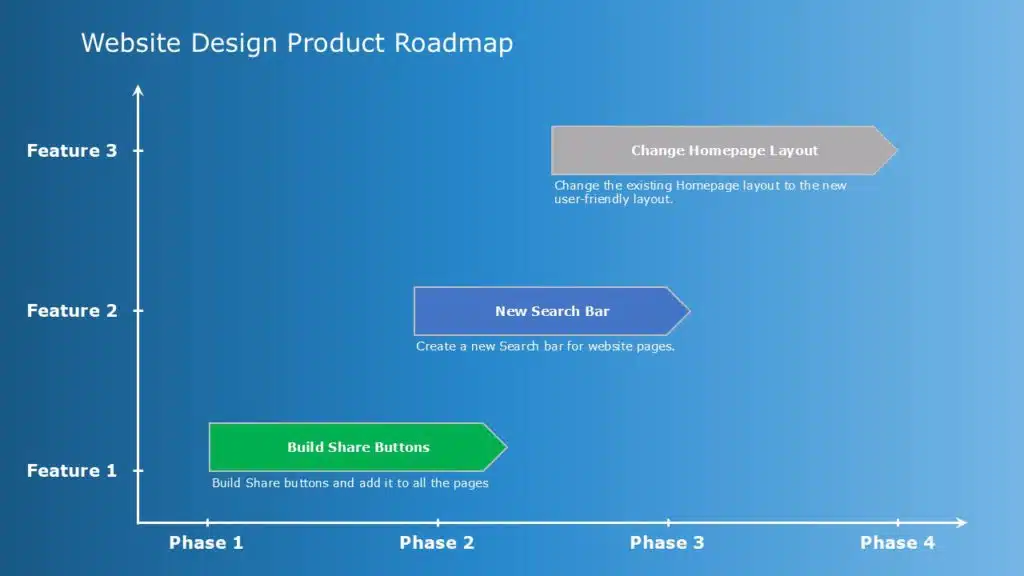
Above is a Feature-oriented product roadmap example that lets you organize and keep track of its development and delivery while focusing on specific features. It helps the team members and clients understand the next course of action.
As a result, customers will recognize the worth of the product, and the team will also be able to understand the development process. You can allocate resources within the organization and prioritize feature releases by implementing a feature-based roadmap. However, the future maintenance of this kind of roadmap will take time as it requires regular updates from user preferences and technical advancements. These are best for development teams that focus on building and improving specific features over time. Feature-based product roadmaps provide you the clarity for prioritizing and developing features.
2. Timeline-Based Product Roadmap Example
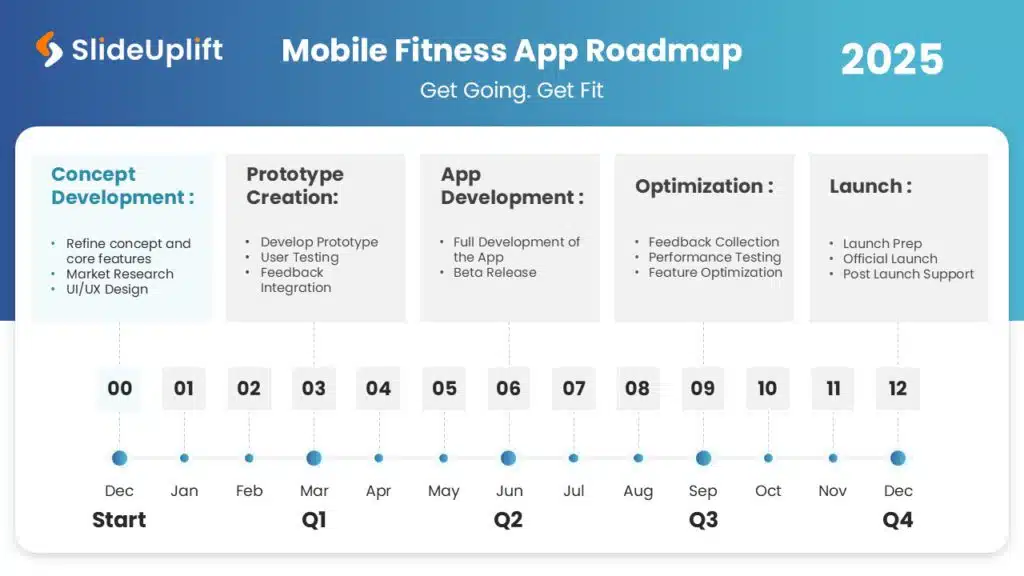
The Timeline-based product roadmaps outline the product’s development journey with a set timeline for project completion. It has clear start and end dates for each phase. It highlights the key initiatives, features, or milestones that are scheduled for specific times. This helps the team and the stakeholders to get a clear view of the progress and deadline of the project.
The timeline-based product roadmap is great for time-sensitive projects. It helps to maintain alignment and transparency about each development stage and its progress and deadlines.
3. Yearly-Based Product Roadmap Example
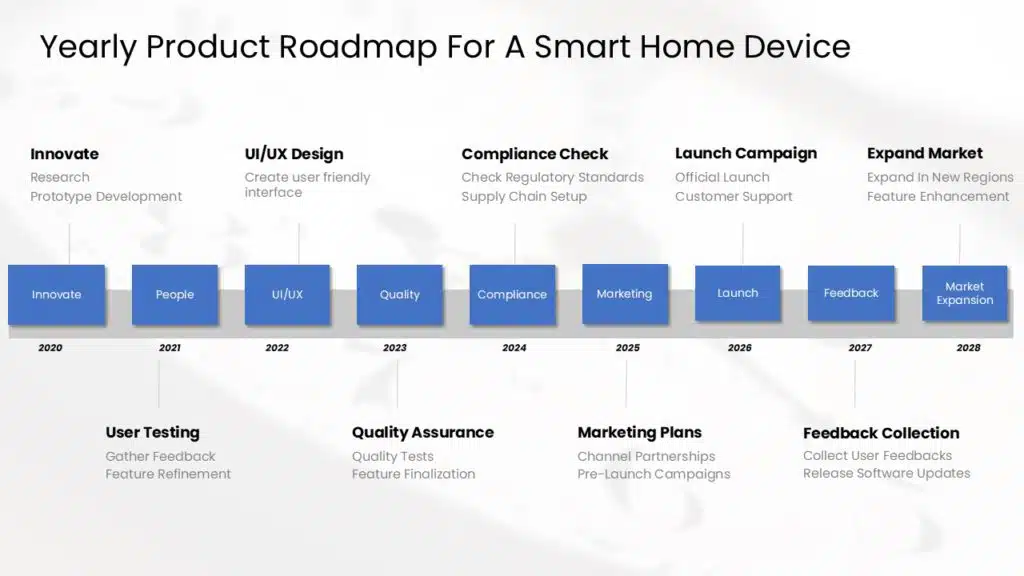
The Yearly-based product roadmap spans multiple years and breaks down the product development roadmap on yearly basis. It is a high-level roadmap that helps map out the product’s development and strategic goals over the long term. It highlights the major activities, planned features, and milestones throughout the years.
A yearly-based product roadmap provides a comprehensive, big-picture view of the product development roadmap journey over the years.These product roadmaps are ideal for aligning cross-functional teams and stakeholders to track long-term goals and resource planning. It provide a clear picture of what to expect over the years.
4. Agile Product Roadmap Example
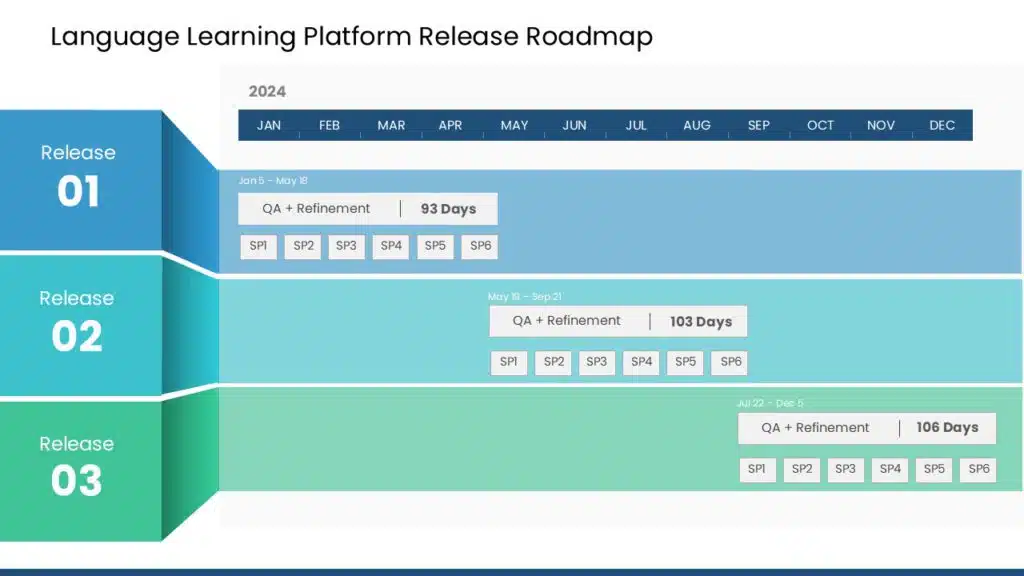
Here is an example of an Agile product roadmap. It is a flexible and iterative product roadmap that focuses on short-term goals. It adapts to changing priorities of the product development process. An agile product roadmap is very different from a traditional product roadmap with a fixed timeline. It is organized based on broad goals and is updated frequently based on the feedback and evolving needs for better product development.
An agile product roadmap helps the product teams to remain responsive to customer inputs, market changes, and new opportunities. It is ideal for fast-paced industry environments where continuous adjustments are needed to stay updated and aligned with the market trends.
5. Goal-oriented Product Roadmap Example
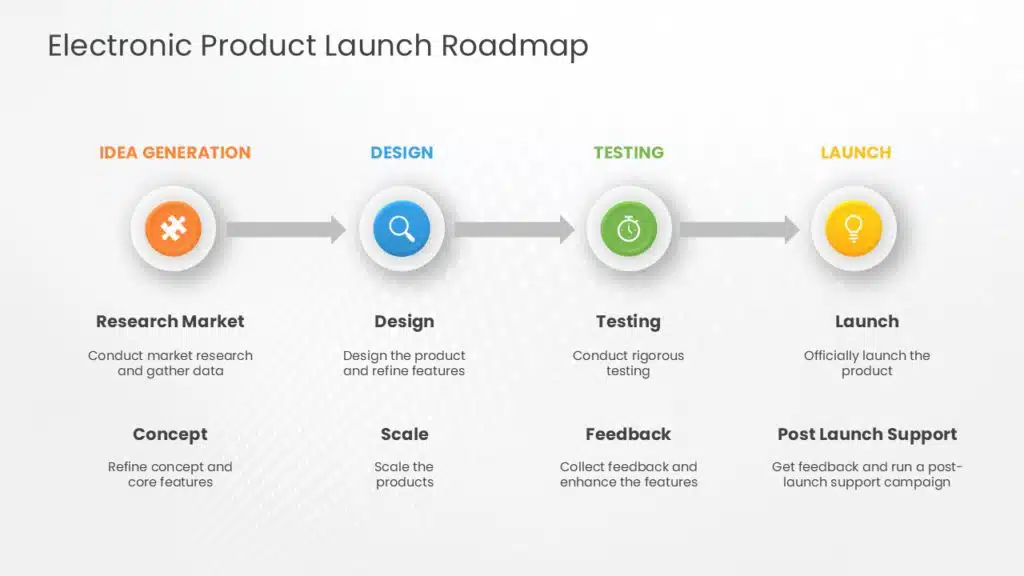
A goal-oriented roadmap makes your approach easier to understand and explains it clearly. The objectives help logically organize information and provide an explanation for each feature. Executives would find great value in viewing this type of map. It arises from a heightened focus on the broader picture and less attention to the specific qualities of the product. A map with specific goals will show whether the product can live up to the hype.
6. Now-next-later Product Roadmap Example
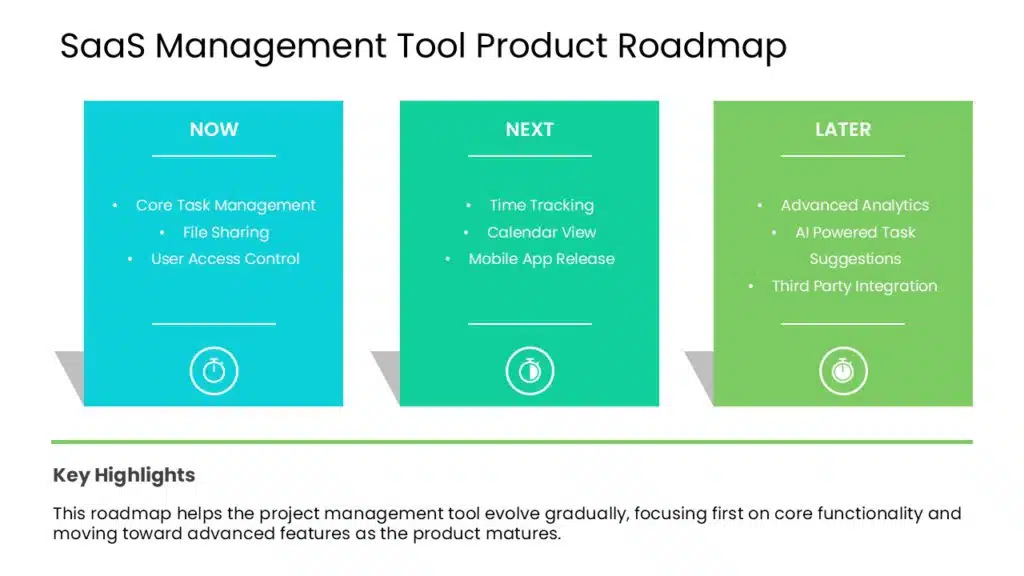
The main feature of the now-next-later roadmap is its simplicity. It facilitates task prioritization. These roadmaps show the relative importance of phases, features, and tasks. Understanding how the work moves forward through the now-next-later roadmap benefits each team member. Moreover, it is simple to comprehend and develop this blueprint. You can use it in meetings with a big group of people or when presenting to clients.
By understanding the above roadmap examples, you can learn which roadmap suits each situation and how to improve it.
Product Roadmap Templates by SlideUpLift
SlideUpLift provides a wide selection of expertly designed product roadmap templates. With a dedication to streamlining the presentation design process, SlideUpLift enables users to construct robust, eye-catching presentations quickly and easily. SlideUpLift offers an extensive library of templates for various presenting requirements, catering to a vast clientele, including educators and business people.
Product Roadmap PowerPoint templates

How to create a Product Roadmap using MS PowerPoint/Google Slides?
Above, we have already discussed some product roadmap examples; now, let’s see how to create one. When making a roadmap in PowerPoint, you can experiment with various design components. You can include a variety of icons, shapes, and other elements in your roadmap presentation, depending on the presentation’s theme.
How to create a product roadmap in PowerPoint:
- Click the “New” tab and select “Blank Presentation” to open the blank PowerPoint presentation slide.
- Once you open the blank slide, two text fields will appear where you can provide the presentation’s title and subtitle. Remove both text areas to create a clear, blank, white presentation slide.
- Click the Insert tab to access the “Shapes” menu. In your slide, insert the “line” shape. Position it so that it is horizontal.
- After making your selection, choose the “Shape Format” option. To change the line’s color, use the Shape Outline option. You can thicken and increase the line’s weight by choosing the Weight option from the same drop-down menu.
- Select the oval shape by clicking the “Insert” menu again. Draw a little circle and position it at one end of the line while holding the shift and control buttons together.
- After selecting the circle, select “Shape Format.” Select the “Shape Fill” tab to alter the circle’s color to your preference.
- Select the hollow circle from the “Shape” menu. Draw a thinner line around the hollow circle and center it around the newly drawn circle. You can modify the hollow circle’s color using the Shape Fill tab. Click the “Ctrl+D” keyboard shortcut to select the hollow circle and copy it. Apply a different color and cover the hollow circle pattern you previously made. Press and hold the Ctrl and Shift buttons simultaneously to enlarge the second hollow circle.
- Make a copy of the straight line by selecting it. Select “Rotate” from the “Shape Format” tab. Choose “90° Rotate Right”. Place the vertical line precisely in the center of the hollow circle. You can resize the line by holding down the shift key.
- Select the arc shape from the Insert tab’s Shapes menu. After moving the yellow dot to form a circle, surround the hollow circle design we have created thus far. Drag the yellow dot to adjust the arc’s direction to match the blueprint design. The Shape Format option lets you modify the arc shape’s outline color and weight.
- Choose a circle that is oval-shaped. Drag it to the opposite end of the vertical line while holding down the Ctrl and Shift keys. Click on the Text Box tab from the Insert menu to add a text box. You can include as many text boxes as the design of your roadmap template requires.
- Choose the entire design. Drag it to the right to duplicate something while holding down the Ctrl and Shift keys. Adapt the horizontal line and text boxes to the needs of the design.
- Once all the elements have been duplicated and adjusted, alter the color of the shapes and lines. Select the Shape Format option. Please select the desired color from Shape Fill and use it to fill the shapes. Using the Shape Outline tab, alter the color of the lines.
- When you prepare the roadmap, save it and give it a file name for later usage.
To simplify editing of the file in the future, save it in the “.pptm” format. Please save the file in.jpg.webp or.pdf format to print it if needed.

How to create a Product Roadmap using SlideUpLift?
Go through the steps below to create a roadmap using SlideUpLift:
- Go to the SlideUpLift website.
- Explore the collection of templates available on SlideUpLift.
- Choose a roadmap template that suits your presentation needs and goals.
- Download the selected template from SlideUpLift.
- Open the downloaded template in Microsoft PowerPoint or Google Slides.
- You can modify the template by altering it to your needs and filling in all the required details.
- You can also change the font and colors of the template according to your wish.
- Enhance the presentation by incorporating visuals such as charts, icons, or images to make the roadmap more engaging.
- Review the entire presentation and make any necessary edits to ensure clarity.
- Save your customized roadmap presentation.

How to prioritize features for the Product Roadmap?
A product roadmap gives your team direction by synthesizing a wide range of inputs, including internal limitations, market research, customer feedback, and resources, into a prioritized list of what needs to be built next. Prioritize efforts based on various criteria to benefit your users directly, build customer value and loyalty, and promote long-term growth.
1. Take Client opinions
Listening to present and potential customers is one of the most important aspects of developing customer-centric solutions that appeal to your target user. Actively seek and analyze input from existing and churned consumers to prioritize products and enhancements that address the most crucial pain points and unmet needs. By taking this stage in the product development process, you can prevent the release of a product that your clients will find unappealing or, worse, unlikable.
2. Consider User behavior data
It’s a mistake to consider just what your customers say; you also need to consider what they do. Data on user behavior provides insightful information on how users interact with your product and what features encourage the most engagement. Understanding user behavior helps you prioritize features and enhancements by pointing out actionable facts, trends, patterns, and bottlenecks that could affect the overall user experience.
3. Research on consumers and markets
To make your product stand out in the market, you must first understand it. By conducting market research, your product team will better grasp customer expectations and what products to build. As a product manager, by integrating the results of market research into your prioritization process, you can make well-informed decisions that meet the needs of the present and future. It ensures your product stays competitive and relevant for the longer run.
4. Consider technical viability
When prioritizing a product roadmap, product managers must consider the accumulation of greater technical debt and technical feasibility. By taking this into account, you can be sure that your development efforts are practical and won’t adversely affect your current technology while being produced within an acceptable time frame and using available resources. Examine any technological constraints and evaluate the enhancements scale. For example, you may discover that adding a new feature necessitates significantly reworking your current IT infrastructure because of technical debt. Depending on your startup’s circumstances, this may or may not be worth it.
5. Know your Resources and Limitations
The roadmap prioritization method would matter less if you had limitless funds and time to produce anything you wanted all at once. However, as a startup, this is most certainly not the case. Consider every possible restriction that can make it more difficult for you to develop essential features and scale product development.
6. Estimate impact and value to business
Pay attention to the elements that will yield the highest return on investment. The ultimate objective of roadmap prioritization should be to maximize business impact while utilizing the least amount of resources and effort possible for your product organization. Your company strategy, key performance indicators (KPIs), and high-level business objectives will determine how your product organization evaluates and affects business value.
7. Assess the possible dangers
Product managers should consider risks and potential benefits when evaluating new features. To reduce potential hazards, assess the drawbacks of creating a new feature. Every element of your product presents certain risks, such as the possibility that users won’t like it, it will consume more team resources, or it will make your product more complicated. While a certain level of risk shouldn’t hinder you from including a feature in your product roadmap, it’s essential to assess the associated risks beforehand.
8. Consider Input from stakeholders
It’s normal for non-members of your product organization to disagree with you on the priorities for the product plan. An investor may insist on developing a feature your significant rival already possesses. Instead of creating a visually appealing new release, your support and sales staff may prioritize addressing critical issues that negatively impact the customer experience. In addition, your real clients may ask you to change an existing feature to suit their requirements better. Hence, it would help if you considered your stakeholder’s input.
How to present a Product Roadmap?
To make the most of your presentation, consider in advance how you will convey your roadmap:
1. Ensure your roadmap aligns with the organization’s overarching strategy and objectives:
Your roadmap needs to align with your company’s objectives and strategy. Ensure that you have completed all the work required to align your roadmap and product vision with the plan and objectives of the company. Make it apparent how your future goals align with those of the company. You will get major stakeholders on board with your strategy if it aligns with the organization’s direction.
2. Determine the impact and areas of interest of your stakeholders
Gain a thorough understanding of stakeholders’ interests in your product. Determine who your stakeholders are and take some time to know. It will help you to speak with them more confidently. The interest and influence matrix is a straightforward and effective method for handling this. Using stakeholder mapping, you can decide who to communicate your roadmap to. Consider who you want in the room (or on the call) and whether you have everyone you need for support. Examine your stakeholder map to help you make informed decisions regarding the guest list.
3. Show compassion for your stakeholders.
Diverse stakeholders possess distinct objectives, incentives, and obstacles. Before your session, take the time to get acquainted with the stakeholders. This effort will help build trust and enhance your understanding of them. Keep in mind that formalized leadership presentations are more appropriate for this purpose. Suppose you already know the close team members you’re presenting to. In that case, you might not need to conduct additional interviews. However, consider arranging some stakeholder interviews if you still need to identify your stakeholders. By doing so, you’ll be able to understand them better. Interviews with stakeholders may be informal.
These are just talks to learn about the difficulties and motives of stakeholders. Stakeholder interviews will assist you in comprehending the organization’s basic structure, how your work fits into the larger picture, and the procedures involved in getting different project components approved.
4. Obtain support from your stakeholders
You may already be familiar with the objectives of the stakeholders. Even so, one-on-one sessions are crucial for planning before presenting your Plan. To avoid surprises, proactively share your roadmap in advance, even through an informal team sync. By engaging in these early discussions, you can more effectively anticipate feedback and identify potential obstacles before your formal presentation. It will be beneficial to consider the effects of your strategy on stakeholders and other departments within your company. Before presenting your roadmap, try to gain support from stakeholders. Recall that the purpose of your presentation is to foster alignment. If you’ve already established buy-in 1:1, you’ll have a far higher chance of being supported by many stakeholders.
How to Manage a Product Roadmap?
Strategic planning and cooperation are necessary for managing a product roadmap effectively. Establishing precise goals and feature prioritization according to value and strategic alignment should come first. Make a visual roadmap with important releases and milestones indicated. Involve stakeholders and cross-functional teams to get feedback and ensure it aligns with business objectives.
Use agile approaches to promote adaptability and responsiveness, and update the plan frequently to consider modifications to the market, consumer input, or priorities. Make sure to explain the roadmap in detail, emphasizing how each item fits into the larger plan for the product. Organize feature dependencies, monitor critical performance metrics, and modify the roadmap as necessary. Gather user input regularly to help with decision-making and have review sessions with the product team to evaluate development and discuss issues.
These guidelines will help you manage product development challenges and keep your roadmap a flexible and helpful tool for accomplishing company goals.
What are the best practices for a Product Roadmap?
Creating a roadmap is a process that requires constant attention and should be rooted in the culture of your product team. Here are a few easy strategies to position yourself for success:
- Provide your viewers with as much information as is necessary.
- Maintain a balanced focus on short-term strategies and how they relate to long-term objectives in the roadmap.
- Regularly review roadmaps and make essential revisions if there are any changes in plans.
- Ensure that the roadmap is accessible to all parties and that they check it frequently.
- Maintain communication with all stakeholders to guarantee alignment.
Conclusion
This article provides valuable insights to enhance team coordination by outlining essential elements for your roadmap. You have to make sure your roadmaps are adaptable. A well-structured roadmap is instrumental in fostering the growth of sales and profitability for your small business or startup, facilitating successful product development.
With the best roadmap templates available, SlideUpLift can help you improve your product presentations. SlideUpLift provides templates that blend style and functionality, making them ideal for managing agile processes, planning product development, or exhibiting technological advancements.
FAQs
-
How to Create a Product Roadmap?
Simply define objectives, prioritize features, and use tools like Gantt charts or specialized software to visualize the plan.
-
What Does a Product Roadmap Look Like?
It resembles a timeline with phases, milestones, and features, visually representing a product’s development journey.
-
What are Some Common Pitfalls Of Product Roadmap?
Common pitfalls include overcommitting to features, neglecting user feedback, unclear prioritization, and failing to adapt to changing circumstances.













